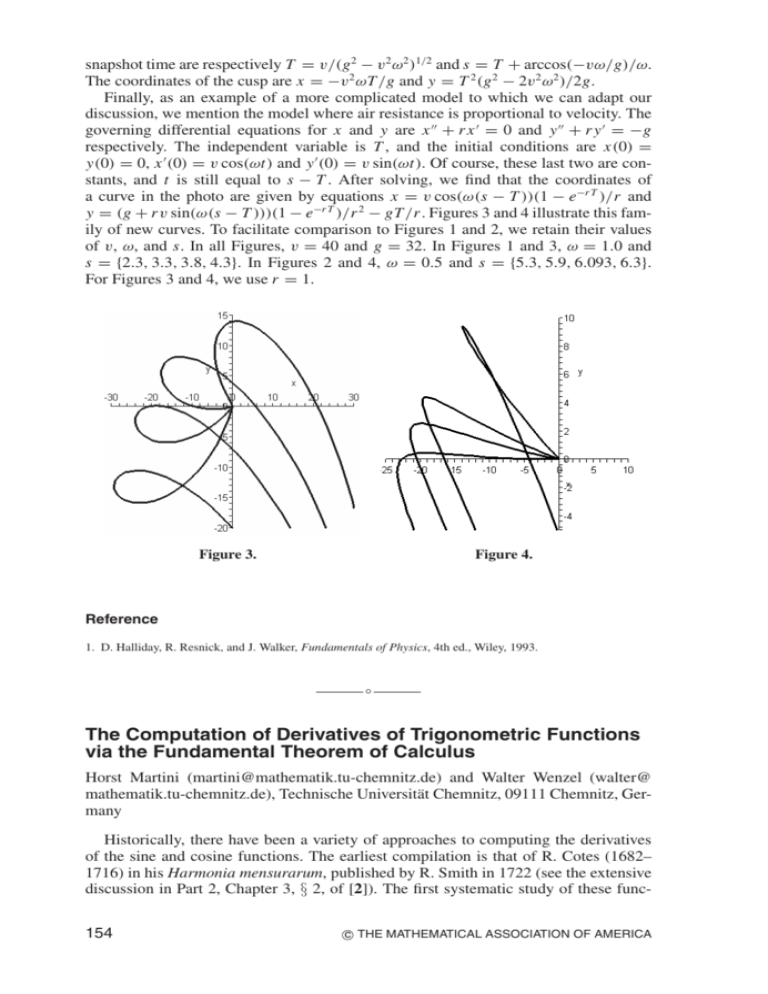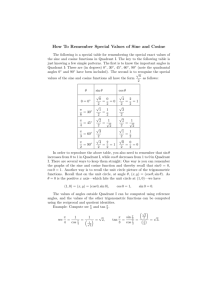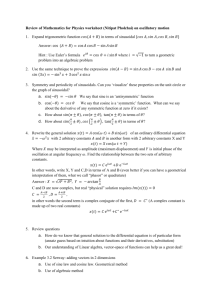The Computation of Derivatives of Trigonometric Functions via the
advertisement

snapshot time are respectively T = v/(g 2 − v 2 ω2 )1/2 and s = T + arccos(−vω/g)/ω.
The coordinates of the cusp are x = −v 2 ωT /g and y = T 2 (g 2 − 2v 2 ω2 )/2g.
Finally, as an example of a more complicated model to which we can adapt our
discussion, we mention the model where air resistance is proportional to velocity. The
governing differential equations for x and y are x + r x = 0 and y + r y = −g
respectively. The independent variable is T , and the initial conditions are x(0) =
y(0) = 0, x (0) = v cos(ωt) and y (0) = v sin(ωt). Of course, these last two are constants, and t is still equal to s − T . After solving, we find that the coordinates of
a curve in the photo are given by equations x = v cos(ω(s − T ))(1 − e−r T )/r and
y = (g + r v sin(ω(s − T )))(1 − e−r T )/r 2 − gT /r . Figures 3 and 4 illustrate this family of new curves. To facilitate comparison to Figures 1 and 2, we retain their values
of v, ω, and s. In all Figures, v = 40 and g = 32. In Figures 1 and 3, ω = 1.0 and
s = {2.3, 3.3, 3.8, 4.3}. In Figures 2 and 4, ω = 0.5 and s = {5.3, 5.9, 6.093, 6.3}.
For Figures 3 and 4, we use r = 1.
Figure 3.
Figure 4.
Reference
1. D. Halliday, R. Resnick, and J. Walker, Fundamentals of Physics, 4th ed., Wiley, 1993.
◦
The Computation of Derivatives of Trigonometric Functions
via the Fundamental Theorem of Calculus
Horst Martini (martini@mathematik.tu-chemnitz.de) and Walter Wenzel (walter@
mathematik.tu-chemnitz.de), Technische Universität Chemnitz, 09111 Chemnitz, Germany
Historically, there have been a variety of approaches to computing the derivatives
of the sine and cosine functions. The earliest compilation is that of R. Cotes (1682–
1716) in his Harmonia mensurarum, published by R. Smith in 1722 (see the extensive
discussion in Part 2, Chapter 3, § 2, of [2]). The first systematic study of these func154
c THE MATHEMATICAL ASSOCIATION OF AMERICA
tions was given by L. Euler in Chapter 8 of [3], for more historical background the
reader is referred to [5]. The derivatives of sine and cosine are particularly important
in physics for solving differential equations, which are derived from physical informations, cf. [1], § 17. The most common method of obtaining the two derivatives is
to start with their elementary trigonometric definitions and then to use the definition
of the derivative in conjugation with some trigonometric identities. However, to prove
those identities in detail takes some work, considering various cases. A different approach is sometimes taken in analysis: The sine and cosine are defined by their power
series. The derivative formulas then follow readily. However, the link to geometry is
far from obvious. Therefore this approach is not suitable to a calculus course.
We take yet another route here. After defining the sine and cosine functions geometrically, we use the Fundamental Theorem of Calculus (FTC for short) to find their
derivatives. Generally, it is much simpler to find derivatives than to compute areas,
but in this case the opposite is true: We evaluate an area in order to find a derivative.
The only trigonometric facts we will use are elementary ones, but we will assume several results from analysis, including the chain rule, the inverse function rule, the mean
value theorem, in addition to the FTC.
We consider the unit disc K := {(x, y) ∈ R2 : x 2 + y 2 ≤ 1} and define the real
number π as the 2-dimensional volume of K . Assume that P0 = (x0 , y0 ) lies on the
boundary of K , that means x02 + y02 = 1. Then the sector of K obtained by rotating
the positive x-axis around the origin counterclockwise until P0 is covered exhibits a
volume which is exactly the half of the angle 0 determined by this sector. Indeed,
this is nothing but a possible definition of the angle 0 ∈ [0, 2π). Next, in the usual
way we define cos 0 and sin 0 by the coordinates of the point P0 :
cos 0 := x0 ,
sin 0 := y0 .
The functions sine and cosine are now determined completely on all of R by periodicity:
sin ( + 2n · π) = sin ,
cos ( + 2n · π) = cos for all ∈ [0, 2π) and all n ∈ Z.
We deduce at once the following identities for all ∈ R:
sin(−) = − sin ,
cos(−) = cos ,
sin(π − ) = sin ,
cos(π − ) = − cos ,
π
π
+ = cos ,
cos
+ = − sin ,
sin
2
2
cos2 + sin2 = 1.
The last equation holds by the theorem of Pythagoras. Furthermore, we observe that
sine defines a bijection from [0, π2 ] to [0, 1], which is strictly increasing. Therefore, the
inverse function arcsin : [0, 1] → [0, π2 ] is defined on [0, 1] and is also strictly increasing. This implies that sine and arcsin are continuous on [0, π2 ] and [0, 1], respectively.
Moreover, the above equations now imply that sine and cosine are continuous on all
of R.
Lemma. The function arcsin is differentiable on [0, 1). More precisely, for 0 ≤ x < 1
we have
VOL. 36, NO. 2, MARCH 2005 THE COLLEGE MATHEMATICS JOURNAL
155
1
arcsin (x) = √
.
1 − x2
√
Proof. Define f : [0, 1] → R by f (x) := 1 − x 2 . Moreover, for 0 ≤ x ≤ 1, let
F(x) denote the area of the region in the first quadrant bounded by the coordinate
axes, the vertical line through P = (x, 0) and the graph of f . Put Q := (x, f (x)); see
−−→
Figure 1. If we now let be the angle from the ray O Q to the positive y-axis, we see
that F(x) is the sum of the areas of a sector of the unit disc K and a triangle; these are
1
· and 12 · x · f (x), respectively.
2
(0,1)
Q = (x, f(x))
⍜
⍜
O
(x,0)
(1,0)
Figure 1.
But = arcsin x, whence
F(x) =
1
1
· arcsin x + · x · 1 − x 2 ,
2
2
and thus
arcsin x = 2 · F(x) − x ·
1 − x 2.
By the Fundamental Theorem of Calculus, we have F (x) = f (x) for 0 ≤ x ≤ 1.
Therefore we obtain for 0 ≤ x < 1:
arcsin (x) = 2 · f (x) −
=
x2
1 − x2 + √
1 − x2
1 − x2 + √
x2
1−
x2
1
=√
.
1 − x2
Theorem. The functions sine and cosine are differentiable on R. More precisely, for
all t ∈ R one has
sin (t) = cos t,
cos (t) = − sin t.
Proof. The above lemma implies that sine is differentiable on [0, π2 ). More precisely, we get for 0 ≤ t < π2 :
156
c THE MATHEMATICAL ASSOCIATION OF AMERICA
1
sin (t) = 1 − sin2 t = cos t.
=
arcsin (sin t)
Note that these equations hold also for t = 0, because sine is an odd function, while
cosine is even. In view of sin (π − t) = sin t and the chain rule, we obtain for π2 <
t ≤ π that
sin (t) = − sin (π − t) = − cos(π − t) = cos t.
For t0 =
π
2
and t ∈ [0, π] \ {t0 } the mean value theorem implies
sin t − sin t0
= sin (t˜) = cos(t˜) for some t˜ with t0 < t˜ < t or t < t˜ < t0 .
t − t0
Thus, it follows also that sin ( π2 ) = cos( π2 ) = 0, because we have already seen that
cosine is continuous.
Furthermore, in view of sin(−t) = − sin t and the chain rule, we get for −π ≤ t ≤
0 that
sin (t) = (−1)2 · sin (−t) = cos(−t) = cos t.
Thus we have proved sin (t) = cos t for all t ∈ [−π, π], whence this formula follows—
in view of periodicity—for all t ∈ R. Finally, we see that cosine is differentiable on R,
too, and that for all t ∈ R we get
cos (t) = sin
π
+ t = cos
+ t = − sin t.
2
2
π
Remark. We would like to point out that the above Lemma and the Fundamental
Theorem of Calculus imply that the length l of an arc of a sector inscribed into the unit
disc equals the angle determined by this sector. Namely, with the above notation we
get for 0 ≤ = arcsin x ≤ π2 :
l=
x x
1 + f (t)2 dt =
0
=
√
0
1+
0
x
1
1 − t2
t2
dt
1 − t2
dt = arcsin x = .
Coming full circle in a sense, we conclude by deriving the identity for the sine of the
sum of two angles—an identity, that is often used to find the derivative of sine. In doing
this, we utilize the following fact from linear differential equations, which could be
independently derived in an elementary manner: If f : R → R is twice differentiable
and f (t) = − f (t) for all t ∈ R, then f (t) = A · sin t + B · cos t for some constants
A, B.
Now fix β and define f : R → R by f (t) := sin(t + β). Then clearly f (t) =
− f (t) for all t ∈ R; thus
f (t) = A · sin t + B · cos t for some constants A and B.
VOL. 36, NO. 2, MARCH 2005 THE COLLEGE MATHEMATICS JOURNAL
157
Taking t = 0 we get B = f (0) = sin β, while t =
cos β. Thus we get for all α, β ∈ R:
π
2
yields A = f ( π2 ) = sin( π2 + β) =
sin(α + β) = sin α · cos β + sin β · cos α.
We leave it to the reader to derive the identity for cos(α + β).
Since this article was accepted, it has been observed that essentially the same approach appears in the book [4] (in Chapter 15). There the author defines π in terms
of arclength instead of area, and starts with the inverse cosine instead of arcsin, but
otherwise covers the same ground.
References
1. A. Budó, Theoretische Mechanik. Deutscher Verlag der Wissenschaften, Berlin, 1987.
2. A. von Braunmühl, Vorlesungen über Geschichte der Trigonometrie. 2 Volumes. Teubner, Leipzig, 1900–1903
(Reprinted Steiner-Verlag, Wiesbaden, 1971).
3. L. Euler, Introductio in Analysin Infinitorum, Bd. 1., Lausanne 1748 (Reprinted, W. Walter, ed., Springer,
1983).
4. M. Spivak, Calculus, 3rd ed., Publish or Perish Press, 1994.
5. M. C. Zeller, The Development of Trigonometry from Regiomontanus to Pitiscus, Edward, Ann Arbor, 1946.
◦
An Upper Bound on the nth Prime
John H. Jaroma (jjaroma@austincollege.edu), Austin College, Sherman, TX 75090
In 1845, J. Bertrand conjectured that for any integer n > 3, there exists at least one
prime p between n and 2n − 2 [1]. In 1852, P. Tchebychev offered the first demonstration of this now-famous theorem. Today, Bertrand’s Postulate is often stated as, “for
any positive integer n ≥ 1, there exists a prime p such that n < p ≤ 2n.”
Furthermore, if we let pn denote the nth prime, then it is not difficult to show by
induction that pn < 2n for n ≥ 2. Given this inequality, it also follows that pn+1 < 2 pn
for n ≥ 3. Contemporary textbooks in number theory which allude to either or both of
these two corollaries of Bertrand’s Postulate include [2], [5], and [6].
Our purpose is to demonstrate that the textbook bound of 2n on the nth prime can
be improved considerably by using a similar technique involving the following 1952
result of J. Nagura [3]. The motivation for this note originated from a lecture the author
recently prepared for his number theory class on the distribution of prime numbers.
Theorem 1 (Nagura).
for n ≥ 25.
There exists at least one prime number between n and 65 n
In particular, observe that the 26th prime is 101 and (1.2)26 ≈ 114.48. Then, by
induction on n, we now have the following result.
Theorem 2.
pn < (1.2)n for n > 25.
Proof. By the preceding observation, the theorem is true for n = 26. Now assume
that for n = k, the result also holds. Hence, for n = k + 1, the induction hypothesis
158
c THE MATHEMATICAL ASSOCIATION OF AMERICA







